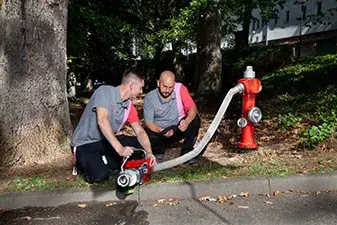Regular maintenance of surface hydrants, underground hydrants and wall hydrants is enormously important. They ensure a reliable and independent water supply for the fire brigade in case of emergency.
Important: Above-ground and underground hydrants are connected to the public water supply network. Therefore, drinking water protection must always be taken into account. If you have any questions, please contact our experts.
What kind of hydrants exist?

There are wall hydrants as well as underground and surface hydrants. A wall hydrant is suitable for use by a layperson as well as by the fire brigade. These are permanently installed water tapping points in buildings. Underground and surface hydrants are used exclusively by the fire brigade to supply water in an emergency.
An underground hydrant is sunk into the ground, e.g. on a road or in a car park, and marked with signs. In the event of an emergency, the fire brigade can use a standpipe to establish a water supply. In contrast, an above-ground hydrant is a permanently installed fitting for drawing water for firefighting. They are often found in residential complexes, city centres or industrial facilities and have different connections (A, B or C).
Wall hydrant maintenance
Wall hydrants with dry risers are to be maintained every two years. All other wall hydrants must be inspected once a year. This is based on DIN EN 671-3 and DIN 14462.
Learn more about wall hydrant maintenance in our blog article.

Maintenance of surface hydrants & underground hydrants

The maintenance of above-ground hydrants and underground hydrants is necessary on a regular basis - at least once a year. Maintenance must be carried out by a competent person in accordance with DIN EN 14339 (underground hydrants with nominal sizes DN 80 and DN 100) and DIN EN 14384 (above-ground hydrants with nominal sizes DN 80, DN 100, DN 150 and PN 16). In addition, the results of the testing of the above-ground or underground hydrant must be recorded in a test book.
In addition, depending on the federal state, an inspection of above-ground and underground hydrants by an expert is required every three to six years in accordance with the Technical Inspection Regulations (TPrüfVO for short).
Our fire protection experts take care of the maintenance and testing of your above-ground hydrants and underground hydrants throughout Germany. With a maintenance contract, we automatically take care of hydrant maintenance - so you never miss an inspection deadline. Contact us now.
FAQ
We give you answers to common questions about hydrants as well as hydrant maintenance. Click on the individual questions & get answers.
How does the fire brigade draw water from an above-ground hydrant and an underground hydrant?
Water is drawn from an underground hydrant by means of a standpipe, which is attached to the underground hydrant with a claw. At the same time, the main shut-off valve is opened so that the hydrant is ready for use. An above-ground hydrant has several outlets (A, B and C) with couplings to which the fire brigade can connect the appropriate hoses directly (or after opening the drop jacket).
What is the water volume of a hydrant?
A hydrant delivers a water quantity of 700 l/min up to 1,500 l/m each. This depends on the capacity of the local water supply network.
What is a drop jacket on a surface hydrant?
An above-ground hydrant with a drop jacket is a sub-type. A drop jacket protects the surface hydrant from dirt and damage, especially in fire-prone areas (e.g. industrial plants). In an emergency, the drop jacket can be opened so that the hydrant can be used by the fire brigade.
What are the advantages and disadvantages of underground and surface hydrants?
An underground hydrant has the disadvantage that they are parked over by vehicles and are therefore not quickly accessible to the fire brigade. Furthermore, in winter when there is heavy frost or snowfall, it is possible that the hydrant cap will freeze or that the underground hydrant must first be searched for under a blanket of snow. Marking for underground hydrants is always required. In contrast, above-ground hydrants are highly visible, so they can be found quickly in the event of a fire. It is not possible for vehicles to park on them. However, an above-ground hydrant cannot be positioned everywhere to avoid obstructing or damaging traffic.
How important is hydrant maintenance?
Hydrant maintenance is enormously important to ensure that hydrants are ready for use at all times. If a hydrant does not work in the event of a fire, this leads to an unnecessary and critical loss of time that must be avoided at all costs. For example, the fire brigade would first have to find the nearest possible hydrant and, if necessary, lay several hundred metres of hoses before a firefighting operation can start. Therefore, hydrant maintenance must be carried out at regular intervals and defects must be rectified as quickly as possible.
The CWS Fire Safety experts will be happy to assist you with the maintenance of above-ground hydrants and underground hydrants. Get in touch now.
Your partner for hydrant maintenance
We are active throughout Germany as a service provider in preventive fire protection. Our regional experts will be happy to assist you with the maintenance of your hydrants.
Do you still have questions about the maintenance of above-ground and underground hydrants?
We will be happy to advise you on the different types of hydrants and regular hydrant maintenance.

